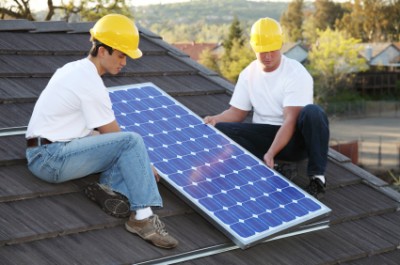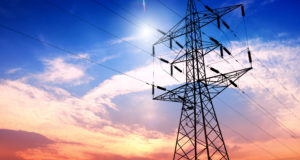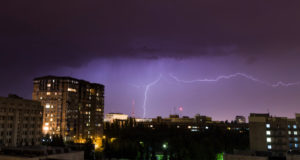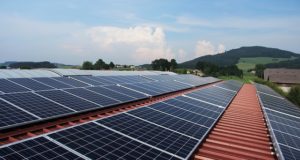What this example reveals is just how critically important it is to have good energy storage capacity, so that the power you rely on to live and survive will always be there when you need it the most. This is especially true for off-the-gridders, who in separating themselves from the inherent unreliability of the grid often choose alternative energy sources that have their own limitations and issues with dependability. Solar, wind, and micro-hydropower are all subject to the vagaries of nature, and when clouds, still conditions, and low water levels render them mute, it is important to have a backup source of energy available that can supply a family with all the electric power it needs to keep a homestead humming along in peace and comfort.
A backup generator that runs on propane would be one possibility, but by the far the most economical, efficient, and downright sensible choice is to have a battery bank available that can be charged to full by the alternative energy system itself. Whenever the sun shines or the wind blows or the water flows, those batteries will be charging, and with the help of an inverter that can transform their DC current into useable AC form, a well-stocked and well-maintained battery bank can smooth out energy delivery patterns and guarantee that a renewable energy set-up will be able to provide a steady source of power all throughout the calendar year. A renewable energy system lacking a battery bank is like a glove without a hand, and even though batteries are not anywhere near as sexy or exciting as a glittering rooftop array of solar panels or a majestic windmill sweeping its perpetual arc across the sky, they are every bit as indispensible for those choosing the non-grid energy route.
Alternative energy enthusiasts could sing the praises of battery banks and the renewable energy set-ups that accompany them until the cows come home, but it is cold, hard statistics that provide the delicious pudding of proof for those who wonder what the future holds for the off-the-grid energy economy. Following a 60 percent decline in the price of solar panels from 2011 to 2012, the interest of US consumers in this energy technology picked up dramatically, and in 2012 alone there was a 76 percent jump in the amount of electricity provided to US homes by residential solar arrays. Wind energy capacity jumped by 28 percent in 2012 as well, making it clear that the market for alternative energy is so bullish at the moment that only the most foolhardy matador would attempt to stand in its way.
Harness the power of the sun for your energy needs…
But if you want to see some really impressive numbers, check out the estimates for the growth of the market for batteries designed to store solar energy collected by home arrays. According to the experts at the UK-based IMS Research, the global market for power storage from solar panels is expected to grow from $200 million in 2012 to $19 billion by 2017. For the mathematically challenged (aren’t we all?), that represents a ninety-five-fold increase in just five years time! Clearly, the market for batteries that will be compatible with off-the-grid alternative energy systems is going supernova, and as suppliers fight for market share, we can expect some substantial improvements in the product and plenty of great deals for the bargain shopper.
If you are planning to make the jump into renewables soon, a good battery bank will undoubtedly comprise a significant part of your investment. There are some great options available already, and with the way research-and-development dollars are starting to flow, even better ones could start hitting the market in the extremely near future. We will offer a preview of some of these coming attractions in part two of this article, but first we will look more closely at the types of batteries that are available on the market right now for those who are ready to install a renewable energy system and will need a battery bank to accompany it.
Lead Acid Is King – At Least For Now
In the early days of the alternative energy movement, pioneers were forced to rely primarily on car batteries to store the power captured by their solar or wind systems. But this solution was never intended to be anything more than temporary, as car batteries were not manufactured to withstand this much strain and would seldom last for much more than a year before burning out.
Eventually, off-the-gridders began to experiment with different varieties of deep-cycle lead-acid batteries, which accept a significant charge and can provide a steady amount of current over a prolonged period of time. This proved to be the ideal solution, as the characteristics of deep-cycle storage cells made them perfect partners for a renewable energy set-up.
All of these moderately sized lead-acid batteries were originally designed for other uses, and interestingly, this situation has not changed very much, as the flexibility of standard deep-cycle batteries made for other macro-scale applications makes them easily adaptable for use in renewable energy systems. Up until now, the market for batteries made exclusively for home-based alternative energy arrangements has simply not been strong enough to support their manufacture (although that situation may change in the very near future).
What It Takes To Create A Safe, Self-Sufficient, Off-The-Grid Lifestyle Using Solar Power!
At the present time, deep-cycle lead-acid batteries are clearly the best choice for use with solar or wind power systems. With one exception, all of the batteries discussed in this section are of the flooded lead-acid (FLA) variety, which means the currents they produce are conducted through a liquid electrolyte that must be replenished regularly (water must be periodically added to the solution to account for attrition). Lead-acid batteries are desirable because they are relatively inexpensive, don’t weigh a ton, and have a consistency in quality and performance that makes them ideal for battery banks that include multiple batteries arranged in sequence and in parallel sets.
The most commonly used lead-acid batteries for off-the-grid residential solar and wind energy systems include the following:
- Golf Cart Batteries: Mass produced by the millions, these batteries have the lowest upfront cost and work well in relatively large battery banks set up to run small-scale renewable energy systems. While a set of four 6-volt, 225-ampere golf cart batteries arranged in sequence will produce just 4 kWh (kilowatt hours) of useable energy, four parallel strings can be set up in a battery bank that will boost that storage total to 16 kWh. Generally battery banks are restricted by a “three-string limit,” meaning that if more than three parallel series are set up to provide energy storage, it can shorten battery life considerably, but golf cart batteries are not bound by this restriction. Golf cart batteries have an average lifespan of four to five years, which is relatively short, but they are extremely durable and can be chronically undercharged and still function just fine. Since small solar arrays or windmills may not be able to collect prodigious amounts of power for the purposes of charging on certain occasions (on cloudy days for solar and still days for wind), this ability to perform even when undercharged adds to the utility of golf cart batteries for those who own relatively small-scale alternative energy systems. A single decent golf cart battery might cost anywhere from $75 to $150, although more expensive high-quality models are available as well.
- L16 Batteries: These FLA batteries were originally designed for use in supermarket floor scrubbers and are perfect for small-to-medium-sized renewable set ups. Their lifespan is somewhat longer than golf cart batteries – five to eight years is their expected survival range – although they are twice as heavy, coming in at a robust 120 pounds in their 6-volt, 350-400 ampere form. These standard 6-volt L16s are approximately two to three times more expensive than golf cart batteries, but L16 batteries are also now available in 2-volt models that have higher kWh storage capacity, which means the same level of storage can be achieved with a reduced number of batteries in a single or in parallel strings. These 2-volt models are somewhat more costly than the 6-volt variety, but overall there should be enough cost savings to justify this investment if the lower voltage isn’t a big problem.
- Industrial Batteries: These potent 300+ pound monsters can kick out an incredible 2,500 amperes of flow per cell. Although a complete set of industrial batteries large enough to store the total collected energy of a residential alternative energy system can run anywhere from $2,000 to $10,000, the amount of kWh of energy saved over their fifteen-to-twenty-year lifespan will provide more bang for the buck than you would be able to get from a battery bank comprised of golf cart or L16 batteries. Because industrial batteries are no longer manufactured to standard dimensions, battery banks for renewable energy systems can be custom-ordered directly from industrial battery manufacturers, allowing the client to choose exactly the storage capacity he wants and needs to get the job done. One thing to keep in mind is that FLAs of all types do require regular care and maintenance if they are to remain in good working order, so those who are sloppy or inattentive in this area could soon find themselves up a creek without a paddle and without enough money to afford bus fare home if they spend thousands on industrial batteries but don’t take proper care of them.
- Sealed Lead-Acid Batteries: In comparison to FLAs, sealed lead-acid batteries that use gelled or absorbed electrolytes offer some real advantages:
- Unlike flooded/unsealed batteries, SLAs require no maintenance beyond proper charging.
- Unlike FLAs, when being charged SLAs produce no gasses that must be vented.
- SLAs work well with small solar arrays and can be charged to lower voltages as lower charge rates.
- No water must ever be added and individual batteries will not need to be equalized to ensure proper operation of the overall system.
- SLAs don’t leak or suffer terminal corrosion.
- The most commonly used type of SLA, Absorbed Glass Mat (AGM), is non-hazardous, and can be shipped between locations without precaution or extra expense.
- SLAs are easily stackable and will take up less space in a battery bank than other alternatives.
But now that we have outlined the advantages of sealed lead-acid batteries, we must acknowledge their two great faults. First of all, they are very sensitive to charge levels and can be easily damaged if overcharged – and they won’t work particularly well if they are kept undercharged, either. And secondly, even though they are twice as expensive as industrial batteries, their lifespan is only half as long, which would seem to make them a bad investment for residential systems in almost every circumstance. Of course as research-and-development progresses, this situation may change, but at least for now they are not the most cost-effective option for those who want to power their homes entirely through the use of renewable energy.
Their expense notwithstanding, sealed lead-acid batteries are still appropriate for use in weekend cabins or in homes that are occupied seasonally, where a small solar array/large battery bank combination can provide all the energy that will be needed without battery functioning being compromised by chronic over- or undercharging. They could also be a good solution in general for those who are not at all keen on maintenance and who are willing to pay to avoid this responsibility.
Somebody Tell The Enterprise – Scotty Needs Better Batteries!
If you are ready to take the leap into renewables now, your battery bank will likely consist of one of the options we have just discussed. But simply choosing which type of battery you would like to purchase and deploy is only the first step in the process; there are a number of factors you must take into consideration before you actually set up your battery bank, and even after you have it up and functioning, you will still need to take care of your batteries properly if you expect your bank to operate at maximum efficiency and to keep working for as long as possible. In part two of this article (appearing next week) we will take a more in-depth look at these critical issues before we conclude our examination of the fascinating world of off-the-grid energy storage by gazing off into the distance to see what new developments may be coming down the pike.
 Off The Grid News Better Ideas For Off The Grid Living
Off The Grid News Better Ideas For Off The Grid Living

 June 3, 2013
June 3, 2013


